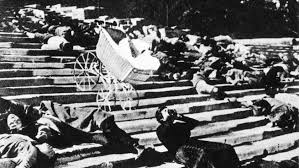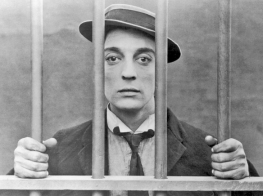



NB. With screening venues beginning to re-open we have started to update our listings but some events remain unconfirmed and others may be cancelled at short notice so be sure to check with the venue before you attend.
1 September
 Battleship Potemkin (Dir. Sergei Eisenstein, 1925) (Screening format – Digital, 75mins) Considered one of the most important films in the history of silent pictures, as well as possibly Eisenstein’s greatest work, Battleship Potemkin brought Eisenstein’s theories of cinema art to the world in a powerful showcase; his emphasis on montage, his stress of intellectual contact, and his treatment of the mass instead of the individual as the protagonist. The film tells the story of the mutiny on the Russian ship Prince Potemkin during the 1905 uprising.Their mutiny was short-lived, however, as
Battleship Potemkin (Dir. Sergei Eisenstein, 1925) (Screening format – Digital, 75mins) Considered one of the most important films in the history of silent pictures, as well as possibly Eisenstein’s greatest work, Battleship Potemkin brought Eisenstein’s theories of cinema art to the world in a powerful showcase; his emphasis on montage, his stress of intellectual contact, and his treatment of the mass instead of the individual as the protagonist. The film tells the story of the mutiny on the Russian ship Prince Potemkin during the 1905 uprising.Their mutiny was short-lived, however, as  during their attempts to get the population of Odessa to join the uprising, soldiers arrived and laid waste to the insurgents. Battleship Potemkin is a work of extraordinary pictorial beauty and great elegance of form. It is symmetrically broken into five movements or acts. In the first of these, “Men and Maggots,” the flagrant mistreatment of the sailors at the hands of their officers is demonstrated, while the second, “Drama on the Quarterdeck,” presents the actual mutiny and the ship’s arrival in Odessa. “Appeal from the Dead” establishes the solidarity of the citizens of Odessa with the mutineers. It is the fourth sequence, “The Odessa Steps,” which depicts the massacre of the citizens, that thrust Eisenstein and his film into the historical eminence that both occupy today. It is unquestionably the most famous sequence of its kind in film history, and Eisenstein displays his legendary ability to convey large-scale action scenes. The shot of the baby carriage tumbling down the long staircase has been re-created in many films. The sequence’s power is such that the film’s conclusion, “Meeting the Squadron,” in which the Potemkin in a show of brotherhood is allowed to pass through the squadron unharmed, is anticlimactic. Find out more at classicartfilms.com With recorded score. BFI Southbank, London Link
during their attempts to get the population of Odessa to join the uprising, soldiers arrived and laid waste to the insurgents. Battleship Potemkin is a work of extraordinary pictorial beauty and great elegance of form. It is symmetrically broken into five movements or acts. In the first of these, “Men and Maggots,” the flagrant mistreatment of the sailors at the hands of their officers is demonstrated, while the second, “Drama on the Quarterdeck,” presents the actual mutiny and the ship’s arrival in Odessa. “Appeal from the Dead” establishes the solidarity of the citizens of Odessa with the mutineers. It is the fourth sequence, “The Odessa Steps,” which depicts the massacre of the citizens, that thrust Eisenstein and his film into the historical eminence that both occupy today. It is unquestionably the most famous sequence of its kind in film history, and Eisenstein displays his legendary ability to convey large-scale action scenes. The shot of the baby carriage tumbling down the long staircase has been re-created in many films. The sequence’s power is such that the film’s conclusion, “Meeting the Squadron,” in which the Potemkin in a show of brotherhood is allowed to pass through the squadron unharmed, is anticlimactic. Find out more at classicartfilms.com With recorded score. BFI Southbank, London Link
12 September
 Battleship Potemkin (Dir. Sergei Eisenstein, 1925) (Screening format – Digital, 75mins) Considered one of the most important films in the history of silent pictures, as well as possibly Eisenstein’s greatest work, Battleship Potemkin brought Eisenstein’s theories of cinema art to the world in a powerful showcase; his emphasis on montage, his stress of intellectual contact, and his treatment of the mass instead of the individual as the protagonist. The film tells the story of the mutiny on the Russian ship Prince Potemkin during the 1905 uprising.Their mutiny was short-lived, however, as
Battleship Potemkin (Dir. Sergei Eisenstein, 1925) (Screening format – Digital, 75mins) Considered one of the most important films in the history of silent pictures, as well as possibly Eisenstein’s greatest work, Battleship Potemkin brought Eisenstein’s theories of cinema art to the world in a powerful showcase; his emphasis on montage, his stress of intellectual contact, and his treatment of the mass instead of the individual as the protagonist. The film tells the story of the mutiny on the Russian ship Prince Potemkin during the 1905 uprising.Their mutiny was short-lived, however, as  during their attempts to get the population of Odessa to join the uprising, soldiers arrived and laid waste to the insurgents. Battleship Potemkin is a work of extraordinary pictorial beauty and great elegance of form. It is symmetrically broken into five movements or acts. In the first of these, “Men and Maggots,” the flagrant mistreatment of the sailors at the hands of their officers is demonstrated, while the second, “Drama on the Quarterdeck,” presents the actual mutiny and the ship’s arrival in Odessa. “Appeal from the Dead” establishes the solidarity of the citizens of Odessa with the mutineers. It is the fourth sequence, “The Odessa Steps,” which depicts the massacre of the citizens, that thrust Eisenstein and his film into the historical eminence that both occupy today. It is unquestionably the most famous sequence of its kind in film history, and Eisenstein displays his legendary ability to convey large-scale action scenes. The shot of the baby carriage tumbling down the long staircase has been re-created in many films. The sequence’s power is such that the film’s conclusion, “Meeting the Squadron,” in which the Potemkin in a show of brotherhood is allowed to pass through the squadron unharmed, is anticlimactic. Find out more at classicartfilms.com With recorded score. BFI Southbank, London Link
during their attempts to get the population of Odessa to join the uprising, soldiers arrived and laid waste to the insurgents. Battleship Potemkin is a work of extraordinary pictorial beauty and great elegance of form. It is symmetrically broken into five movements or acts. In the first of these, “Men and Maggots,” the flagrant mistreatment of the sailors at the hands of their officers is demonstrated, while the second, “Drama on the Quarterdeck,” presents the actual mutiny and the ship’s arrival in Odessa. “Appeal from the Dead” establishes the solidarity of the citizens of Odessa with the mutineers. It is the fourth sequence, “The Odessa Steps,” which depicts the massacre of the citizens, that thrust Eisenstein and his film into the historical eminence that both occupy today. It is unquestionably the most famous sequence of its kind in film history, and Eisenstein displays his legendary ability to convey large-scale action scenes. The shot of the baby carriage tumbling down the long staircase has been re-created in many films. The sequence’s power is such that the film’s conclusion, “Meeting the Squadron,” in which the Potemkin in a show of brotherhood is allowed to pass through the squadron unharmed, is anticlimactic. Find out more at classicartfilms.com With recorded score. BFI Southbank, London Link
29 September
 The Great Buster (Dir. Peter Bogdanovich, US, 2018) The Great Buster celebrates the life and career of one of America’s most influential and celebrated filmmakers and comedians, Buster Keaton, whose singular style and fertile output during the silent era created his legacy
The Great Buster (Dir. Peter Bogdanovich, US, 2018) The Great Buster celebrates the life and career of one of America’s most influential and celebrated filmmakers and comedians, Buster Keaton, whose singular style and fertile output during the silent era created his legacy  as a true cinematic visionary. Filled with stunningly restored archival Keaton films from the Cohen Film Classics library, The Great Buster is directed by Peter Bogdanovich, a filmmaker and cinema historian whose landmark writings and films on such renowned directors as John Ford and Orson Welles have become the standard by which all other studies are measured. Find out more at cohenmedia.net. Followed by Q&A with film historian, critic and founder of Silent London, Pamela Hutchinson. Genesis Cinema, London Link
as a true cinematic visionary. Filled with stunningly restored archival Keaton films from the Cohen Film Classics library, The Great Buster is directed by Peter Bogdanovich, a filmmaker and cinema historian whose landmark writings and films on such renowned directors as John Ford and Orson Welles have become the standard by which all other studies are measured. Find out more at cohenmedia.net. Followed by Q&A with film historian, critic and founder of Silent London, Pamela Hutchinson. Genesis Cinema, London Link
